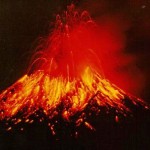 Citizen science has been one of the most effective and exciting applications of crowdsourcing, with a whole heap of fascinating projects benefiting from pulling the crowd of enthusiastic amateurs into their endeavours. Whilst many of these projects have important goals in mind, there is one that has arguably a more important outcome than most.
Citizen science has been one of the most effective and exciting applications of crowdsourcing, with a whole heap of fascinating projects benefiting from pulling the crowd of enthusiastic amateurs into their endeavours. Whilst many of these projects have important goals in mind, there is one that has arguably a more important outcome than most.
In the Ecuadorian Andes is a volcano called Tungurahua, or the Throat of Fire as it’s known. Living safely in the vicinity of such an active volcano requires diligent monitoring and planning. A job for the experts you would imagine. Except that crucial role is taken by a team of 35 citizen scientists, known as vigias.
A recent paper shows the extent of their role in keeping the neighbouring area safe. A recent eruption of the volcano led to the 25,000 inhabitants of nearby Banos being evacuated. But leaving homes, land and livelihoods was hard, and the community rallied together to over-run checkpoints and re-occupy the town.
“This pattern of re-occupation is common in volcanic areas and after other natural disasters. The people of Baños wanted to go home even though it wasn’t safe. The vigías are members of the community who help scientists collect data about volcanic activity, are part of a vital early warning system for eruptions, and facilitate evacuations of the community during a crisis.
“The network enables citizens to continue to live and work in a hazardous area by enhancing their capacity to respond quickly to escalating threats. The ideal risk reduction scenario would be to move people out of the way of the volcano permanently, but clearly this is not always practical – people often want to live and work in particular locations for a number of reasons, and anyway – there are few places that you can move in the Ecuadorian Andes that aren’t threatened by one or several volcanoes!” the researchers say.
One particular eruption in the summer of 2006 is focused on in the paper. It highlights how the citizen science network of the vigia saved a considerable number of lives during that disaster. What’s more, subsequent eruptions last year suffered no casualties at all, which again, was largely attributed to the work of the citizen volunteers and their swift response.
“Community based monitoring has the potential to reduce risk by providing useful data, fostering collaboration between scientists and communities, and providing a way in which citizens are empowered to take actions to preserve lives and livelihoods,” the researchers say.
In an attempt to understand why the citizen science network was so effective, the researchers conducted a series of interviews with the volunteers.
“The area is potentially becoming more dangerous with villages and grazing lands around the volcano’s base particularly at risk. One of the reasons why the vigías network really works is because they have a vested interest to be ready for the next eruptive event. They want to work with the authorities to help their communities,” they say. “Scientists are considered friends and colleagues, which also has a big impact on the success of the network. The vigías act as a bridge between the community and the scientists. The communities are able to more rapidly trust and act upon advice from the scientists and authorities, because of the vigías.”
With something like 600 million people around the world said to live close to a volcano, this kind of citizen science network could play a crucial role in securing the safety of those people. Another cool example of the power of the crowd.
Very interesting paper! We've tended to think of citizen science as being confined to web-based projects like the stuff on Zooniverse, but this points to much broader applications.
Yes, it's interesting how far it can potentially go. Thanks for the comment Chandra (and nice website)